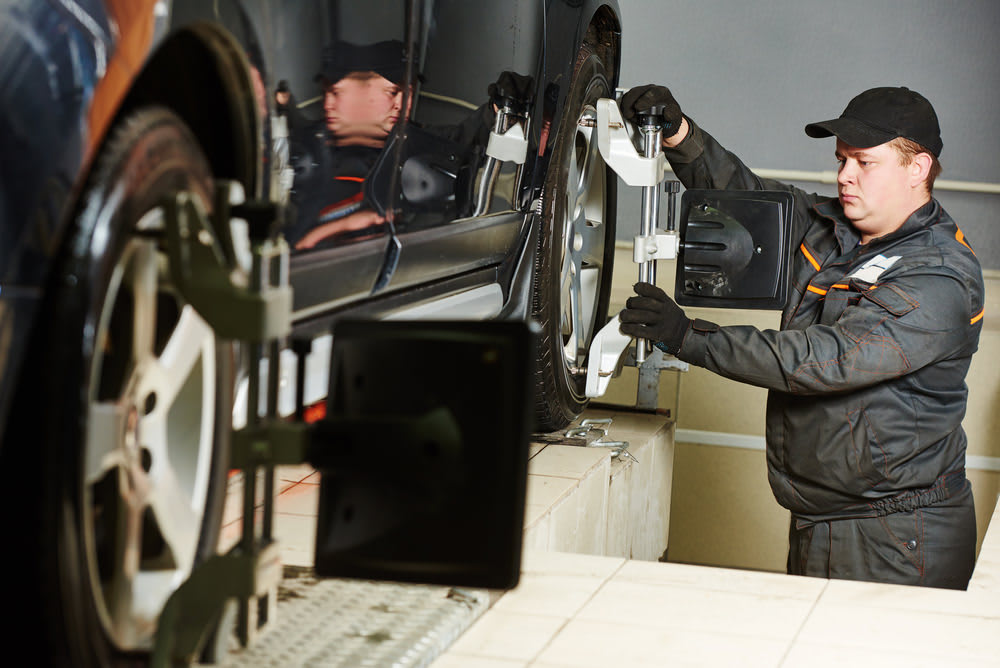

Among routine vehicle maintenance items, wheel alignment may be the most misunderstood. After all, aren’t a car’s or truck’s wheels already “aligned” at the factory? Why should a vehicle owner need to worry about alignment at all?
Modern suspension systems offer certain adjustments to allow for such variables as manufacturing tolerances, wear, changes in tires, and even accidents. But wherever there’s an adjustment it’s possible for parts to wear over time or to slip a little bit (particularly when bumped hard), resulting in misalignment. Also, any time something related to the suspension changes, as when a new set of tires are installed, alignment can change as a result. Periodically checking and adjusting the alignment is a necessary part of keeping every vehicle running safely and economically.
To understand why periodic alignment is important, it’s helpful to know a bit about what aspects of alignment can be adjusted. The major alignment adjustments are:
Toe: While tires should face almost directly forward, sometimes slight deviations from that are used to help the vehicle track straight even on rough or crowned roads; these deviations from straight forward are called toe. Excessive toe (inward or outward) dramatically increases tire wear and can decrease fuel economy because the tires rub against the road instead of merely rolling, and large deviations from proper toe settings can make a vehicle difficult to control.
Camber: The extent to which tires are tilted toward or away from the center of the vehicle, when viewed from the front or rear, is called camber. If the tires are exactly vertical (0° of camber) then acceleration and braking performance are maximized, while a slight tilt of the tops of the tires toward the inside (called negative camber) can help handling because it compensates for the forces incurred during cornering. When camber is even a little bit too great (positive or negative), tire wear increases greatly because one edge of the tire takes all the load; when camber is badly misadjusted, safety becomes an issue as braking performance suffers.
Caster: Caster, which is usually adjustable only on the front tires, is the difference between where a tire touches the road and the point at which it pivots when turned. Picture the front wheels of a shopping cart, which automatically align themselves when the vehicle is pushed forward, to understand why this can be important. Correct caster settings help the vehicle track straight; incorrect settings can make the vehicle unstable or difficult to turn.
There’s a common theme to all three adjustments: when they’re set right, the vehicle performs well, but even a small deviation from the correct settings can increase tire wear, reduce fuel economy, and render the vehicle difficult or even unsafe to drive. Thus, driving a car, truck, or utility vehicle whose suspension is misaligned costs money (in extra tire and fuel costs) and can be unpleasant or even hazardous.
How often to check alignment
If you notice changes in your vehicle’s handling or steering, you may need an alignment. First check to ensure that the tires are properly inflated, and if they are or if inflating them properly doesn’t fix the problem, an alignment may be in order.
Any time you have new tires installed, getting an alignment is a good idea. This is particularly important when changing to a different brand or model of tire, and it’s definitely necessary when changing wheel sizes.
If the vehicle is in an accident, even one that doesn’t seem very serious, or if you hit an obstacle hard with one or more of the wheels, get the alignment checked. Even a seemingly minor bump like running over a curb can throw the alignment far enough off to warrant an alignment.
Periodically checking the alignment, even if none of the above occurs can produce long-term savings, primarily in reduced tire cost. If it’s been two years or 30,000 miles since the vehicle’s last alignment, it’s probably time to have it checked; every 15,000 miles is more like it if you drive on rough roads a lot.
One thing to note when getting an alignment: you can have either a two-wheel (the fronts only) or four-wheel alignment. If your vehicle has an adjustable rear suspension (as most cars and trucks sold in the last 30 years do), then it’s almost always worth the small incremental cost to get the four-wheel alignment, for the long term savings on tire cost if nothing else.



